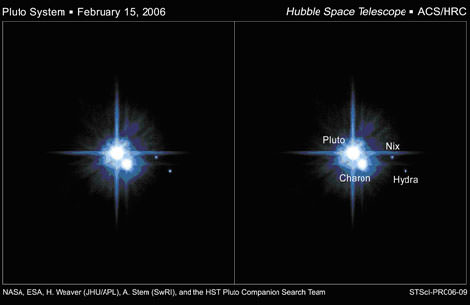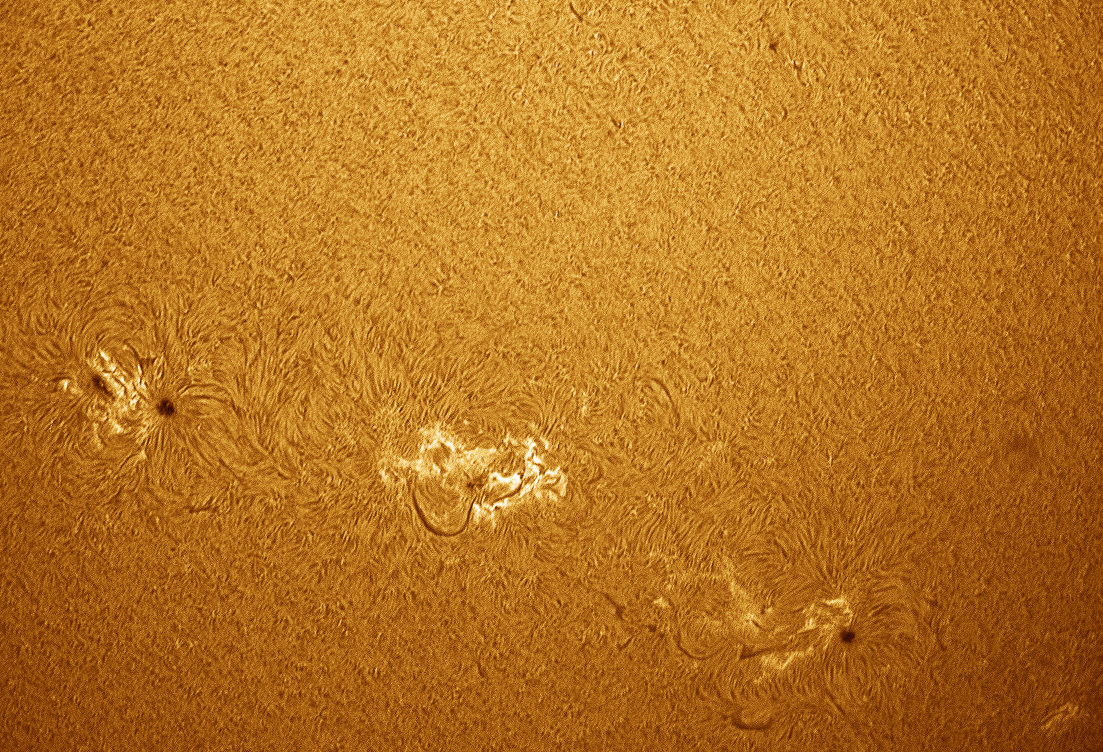X-Class, M-Class, C-Class… What does it all that mean, and just what is a solar flare? This video from the Solar Dynamics Observatory tells all about solar flares and how they might affect us here on Earth. Find out why NASA and NOAA are constantly monitoring the Sun for activity that could create long lasting radiation storms which can harm satellites, communications systems, and even ground-based technologies and power grids.
Sun Erupts with Largest Solar Flare of the Cycle
Early Tuesday morning (August 9, 2011,) the Sun erupted with the largest solar flare of Cycle 24, registering as an X7-class flare. This flare had an X-ray magnitude of X6.9, meaning it was more than 3 times larger than the previous largest flare of this solar cycle – the X2.2 that occurred on Feb 15, 2011, NASA said. The source was Sunspot 1263 which is nearing the western limb of the Sun, and because of its location, scientists do not anticipate that this explosion will hit Earth directly. Therefore, the impact on communications and electric grids will likely (and luckily) be minimal.
Continue reading “Sun Erupts with Largest Solar Flare of the Cycle”
Ring System Around Pluto?
[/caption]
With the New Horizons spacecraft on its way to Pluto, there may be an intriguing additional task for the mission’s science team: look for a potential ring around Pluto and its moons. Researchers at The Universidade Estadual Paulista in Brazil have recently submitted a paper for publication in which they explore the possibility of a ring system around the Pluto-Charon system. In their paper, the team discusses the effects of micrometeoroid impacts on Nix and Hydra and how the resulting dust particles could form a ring around Pluto. The team also investigates forces, such as the solar wind, which would dissipate said ring system.
Pryscilla Maria Pires dos Santos and her team provide an exhaustive list of calculations in their paper which estimates the ring system to have a diameter of nearly 16,000 kilometers – well outside the orbits of Nix and Hydra. Based on their calculations, Pires dos Santos state that despite nearly 50% of the ring’s mass being dissipated within a year, a tenuous ring system can be maintained by the dust expelled by micrometeoroid impacts.
Additional data presented in the paper places the rings “optical depth” as being several orders of magnitude fainter than even Jupiter’s rings. (Yes, Jupiter has a ring system!) While ground-based observatories and even the Hubble Space Telescope haven’t detected the ring system Pires dos Santos et al. are hopeful that the New Horizons mission will provide data to validate their theoretical models. New Horizons has a dust counter capable of measuring dust grains with a minimum mass of 10-12 grams, which should provide the data required to support or refute the team’s models.
Pires dos Santos mentions: “It is worth to point out that the interplanetary environment in the outer Solar System is not well known. Many assumptions have to be made in order to estimate a normal optical depth of a putative ring encompassing the orbits of Nix and Hydra.”
If you’d like to read the full paper, you can access it (for free) at: http://arxiv.org/PS_cache/arxiv/pdf/1108/1108.0712v1.pdf
Source: arXiv:1108.0712v1 [astro-ph.EP]
How Big Are Solar Flares?
With the recent activity on the Sun, we’ve used the words “massive” or “huge” to describe solar flares. But just how big are they, really? This great video explains and illustrates the actual size of solar flares.
Thanks to Scott Stevenson for creating and sending us the video. Scott notes that text subtitles are available if you click on the “CC” button on the bottom of the video screen, making this informative video accessible to a wider audience.
Solar Storm Heading Our Way
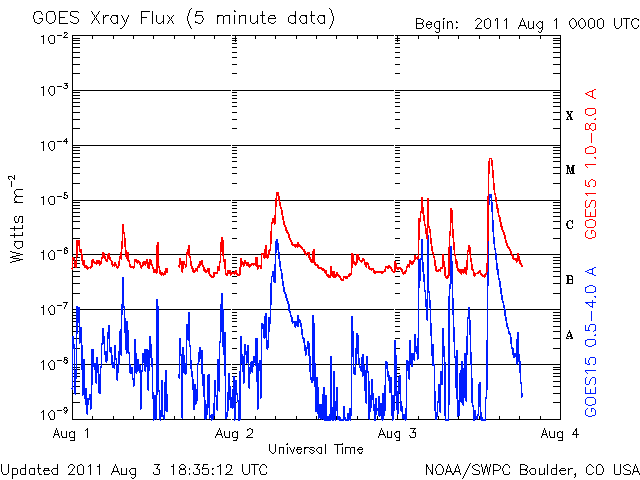
Early today, (Aug 3, 2011) two active regions on the Sun, sunspot 1261 and 1263 unleashed solar flares, which was captured by NASA’s Solar Dynamics Observatory. The above video shows an M6 class flare from 1261 in a couple of different wavelengths. SolarstormWatch, a citizen science project through the Royal Observatory in Greenwich, England predicts the solar storm from the larger flare to reach Earth at 15:00 UTC on August 5, 2011, and also predict direct hit on Earth.
See below for a graph of the activity:
[/caption]
Solar storms are a concern if they hit Earth directly since under the right conditions, they can create extra electrical currents in Earth’s magnetosphere. The electrical power grid is vulnerable to any extra currents, which can infiltrate high-voltage transmission lines, causing transformers to overheat and possibly burn out.
Check SpaceWeather.com and the National Weather Service’s Space Weather Prediction Center for more information.
Activity Heating Up on the Sun!
[/caption]
The summer Sun (for us in the northern hemisphere) is getting active! Here are images and videos of recent activity, which include sunspots and an M-class flare. Above is a close-up look at four active regions taken by César Cantú from the Chilidog Observatory in Monterrey, Mexico.
Below, see a strong but brief M9-class solar flare which occurred on July 31, 2011 from Active Region 1261, captured by the Solar Dynamics Observatory. Scientists from SDO say that because it was brief it appears not to have hurled a large coronal mass ejection (CME) outwards.
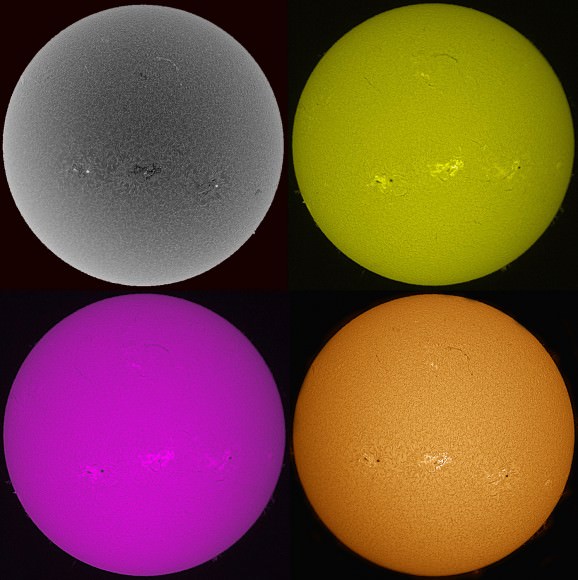
Here’s a comparative look at the sunspots from August 1, 2011, taken by César Cantú from the Chilidog Observatory in Mexico. “Taking advantage of the program that I could attach Lucam Recorder in AVI (video) different bands of light, here is this comparative look in negative, white light, the calcium band and hydrogen-alpha band,” said Cantú. He used a 90 Coronado telescope and camera with dual ektalon DMK41.
See more at the Chilidog Observatory website, Astronomía Y Astrofotografía.
Here’s a video clip from SDO showing an interesting alignment of three good-sized sunspot groups that appear to be marching across the Sun, taken July 28-29, 2011.
See more, and keep up with all the activity on the Sun at the SDO website.
Amber Waves Of Energy
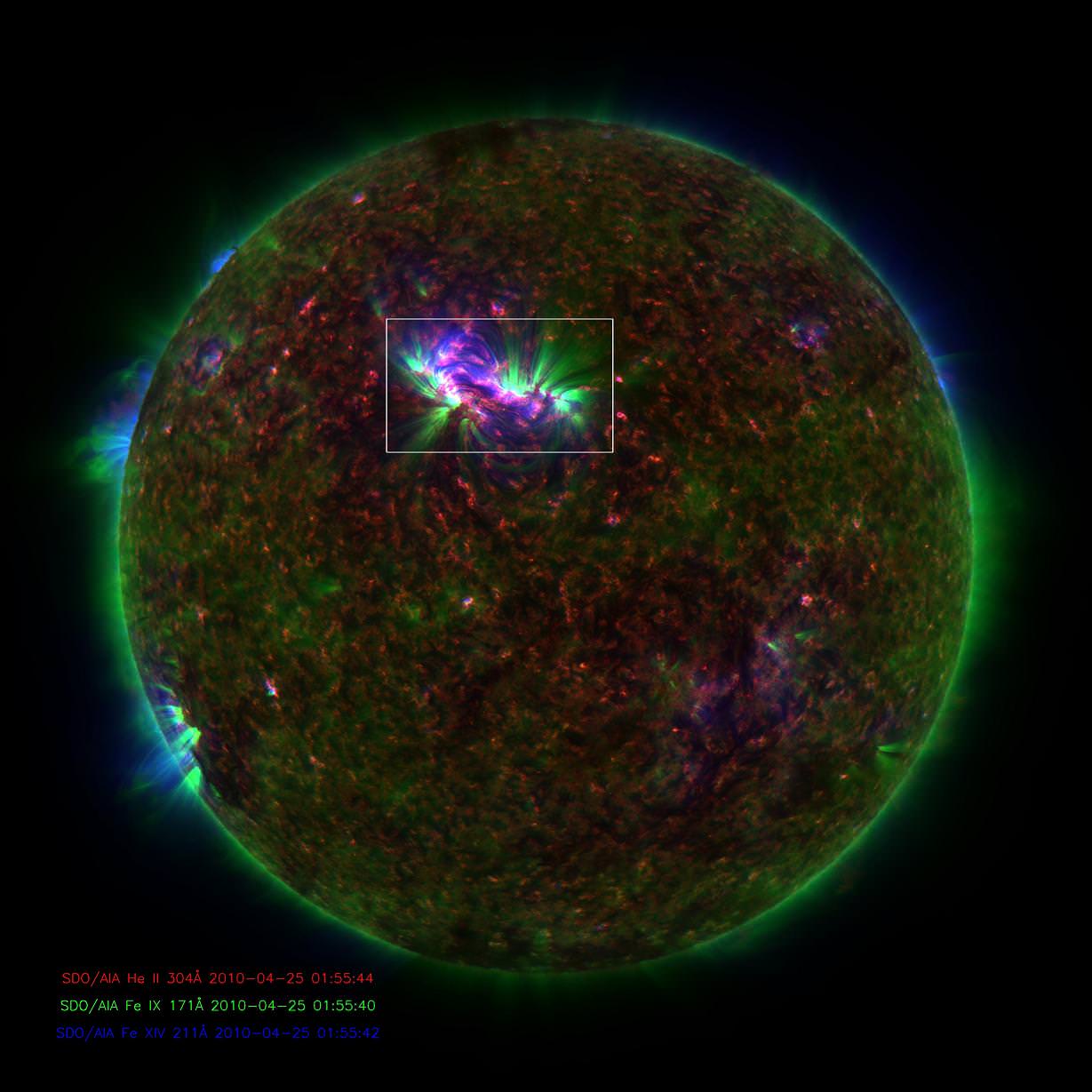
[/caption]
Have you ever seen the hot summer wind blow across a ripening field of wheat? If so, you’re familiar with the rippling effect. Now imagine that same crop – only the stalks are 32,000 feet high and on the surface of the Sun. This cascading effect is called Alfvén waves.
Thanks to NASA’s Solar Dynamics Observatory (SDO), we’re now able to see the effect of Alfvén waves, track their movements and see how much energy is being carried along. These new findings have enlightening solar researchers and may be the key to two other enigmatic solar occurrences – the intense heating of the corona to some 20 times hotter than the Sun’s surface and solar winds that blast up to 1.5 million miles per hour.
“SDO has amazing resolution so you can actually see individual waves,” says Scott McIntosh at the National Center for Atmospheric Research in Boulder, Colo. “Now we can see that instead of these waves having about 1000th the energy needed as we previously thought, it has the equivalent of about 1100W light bulb for every 11 square feet of the Sun’s surface, which is enough to heat the Sun’s atmosphere and drive the solar wind.”
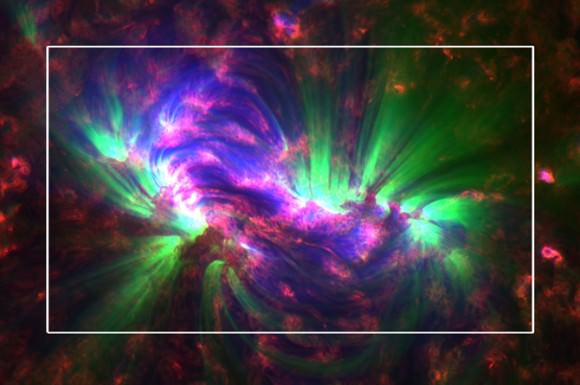
As McIntosh points out in his July 28 Nature article, Alfvén waves are pretty simple. Their movement undulates up and down the magnetic field lines similar to the way a vibration travels along a guitar string. The plasma field enveloping the Sun moves in harmony with the field lines. The SDO can “see” and track this movement. Although the scenario is much more complex, understanding the waves is key to understanding the nature of the Sun-Earth connection and other less clear cut questions such as what causes coronal heating and speeds of the solar wind.
“We know there are mechanisms that supply a huge reservoir of energy at the sun’s surface,” says space scientist Vladimir Airapetian at NASA’s Goddard Space Flight Center in Greenbelt, Md. “This energy is pumped into magnetic field energy, carried up into the sun’s atmosphere and then released as heat.” But determining the details of this mechanism has long been debated. Airapetian points out that a study like this confirms Alfvén waves may be part of that process, but that even with SDO we do not yet have the imaging resolution to prove it definitively.
Hannes Alfvén first theorized the waves in 1942, but it wasn’t until 2007 that they were actually observed. This proved they could carry energy from the Sun’s surface to the atmosphere, but the energy was too weak to account for the corona’s high heat. This study says that those original numbers may have been underestimated. McIntosh, in collaboration with a team from Lockheed Martin, Norway’s University of Oslo, and Belgium’s Catholic University of Leuven, analyzed the great oscillations in movies from SDO’s Atmospheric Imagine Assembly (AIA) instrument captured on April 25, 2010. “Our code name for this research was ‘The Wiggles,'” says McIntosh. “Because the movies really look like the Sun was made of Jell-O wiggling back and forth everywhere. Clearly, these wiggles carry energy.”
The “wiggles” – known as spicules – were then modeled against Alfvén waves and found to be a good match. Once pinpointed, the team could then could analyze the shape, speed, and energy of the waves. “The sinusoidal curves deviated outward at speeds of over 30 miles per second and repeated themselves every 150 to 550 seconds. These speeds mean the waves would be energetic enough to accelerate the fast solar wind and heat the quiet corona.” says the team. “The shortness of the repetition – known as the period of the wave – is also important. The shorter the period, the easier it is for the wave to release its energy into the coronal atmosphere, a crucial step in the process.”
According to preliminary data, the spicules leaped to coronal temperatures of at least 1.8 million degrees Fahrenheit. The pairing of Alfvén waves and heat may just be what it takes to keep the corona at its current temperature… but not enough to cause radiation bursts. “Knowing there may be enough energy in the waves is only one half of the problem,” says Goddard’s Airapetian. “The next question is to find out what fraction of that energy is converted into heat. It could be all of it, or it could be 20 percent of it – so we need to know the details of that conversion.”
More study? You betcha’. And the SDO team is up to the task.
“We still don’t perfectly understand the process going on, but we’re getting better and better observations,” says McIntosh. “The next step is for people to improve the theories and models to really capture the essence of the physics that’s happening.”
Original Story Source: NASA SDO News.
Magnetic Ropes Skip To Solar Storms
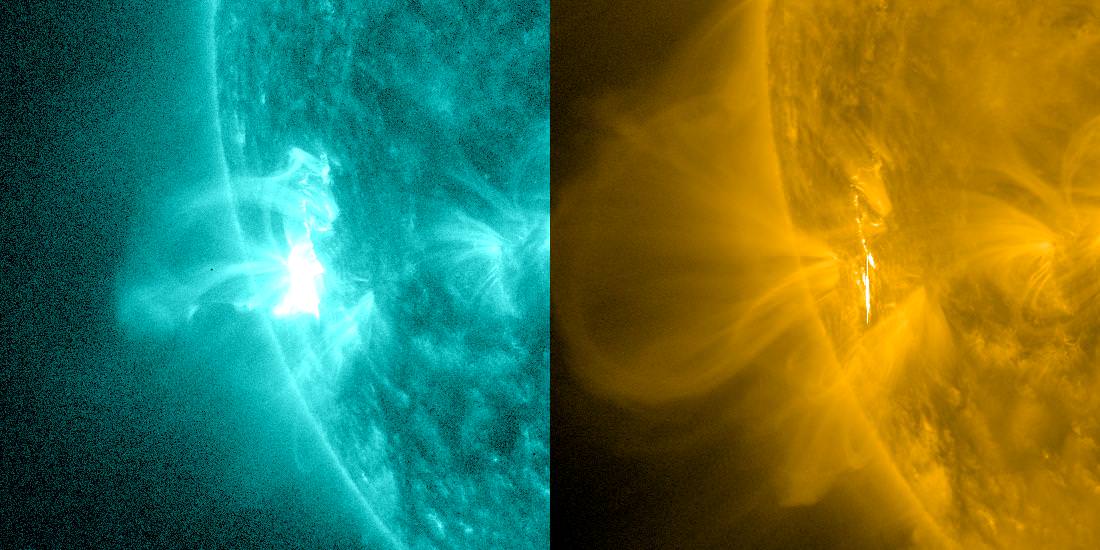
[/caption]
It is our current understanding that the Sun’s magnetic fields and field lines are the cause of solar storms. However, there is no solid evidence as to what form magnetic field lines may take ahead of an energetic outbreak. We know there can be loops connected to the surface – but normally they take the sting off an eruption, rather than cause one. Thanks to a discovery made by associate professor Jie Zhang and his graduate student Xin Cheng using images from the NASA Solar Dynamics Observatory (SDO) spacecraft, we’re shedding a little light on a solar mystery.
An event called a magnetic rope is assumed to be the progenitor of solar storms – but its existence was far from certain. The phenomena may consist of many magnetic field lines wrapping around a center axis – possibly twisting around each other – and producing an electric current. The current might then be able to generate enough electromagnetic force to overpower the withholding magnetic field lines and cause the rope to move outward at speeds we so far haven’t been able to document… Until now.
Thanks to the images taken by the Atmospheric Imaging Assembly (AIA) telescope on board the SDO, Zhang was able to isolate an area of the Sun where a magnetic rope was forming. What the images provided was a unique look at an active region ahead of an eruption. Revealed was a long and low-lying channel which produces temperatures up to 10 million degrees – and continues heating. When it reaches a critical point this “hot channel” reveals a never before seen feature unlike the surrounding magnetic field lines… possibly the theoretical magnetic rope.
“The magnetic rope triggers a solar eruption. Scientists have been debating whether or not this magnetic rope exists before a solar eruption. I believe that the result of this excellent observation helps finally solve this controversial issue,” says Zhang.
As we’re all aware, it would be a boost to understand and predict solar storms. While our Earth’s “magnetic shield” protects us from the majority of direct exposure, we have satellites, astronauts and terrestrially-based power sources which could benefit from an early warning scenario.
“Understanding the eruption process of these storms will definitely help us better predict them,” says Zhang. “We cannot prevent solar storms, just like we cannot prevent earthquakes or volcanoes. But the development of prediction capacity can help mitigate adverse effects. For instance, satellite operators can power-down key systems to prevent the possible damage to the systems.”
Original Story Source: MSNBC.
Sun Celebrates Solstice With Flare (and a CME)
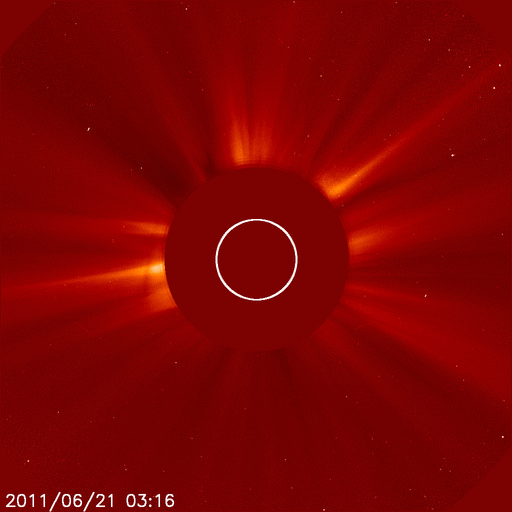
[/caption]
Late in the evening on June 20, 2011 the Sun emitted a long lasting C7.7 class flare (a relatively small flare) that peaked around 11:25p.m. EDT. The flare was associated with a coronal mass ejection that bloomed off the sun at 11:09p.m. EDT (0412 UT).
Spaceweather.com reports that according to analysts at the Goddard Space Flight Center Space Weather Lab, the CME left the sun traveling 800 km/s and it will reach Earth on June 23rd at 23:22 UT (plus or minus 7 hours). A very cool 3D heliospheric model (below) shows the cloud sweeping past our planet. The impact is expected to trigger a G2-class geomagnetic storm.
High-latitude sky watchers should be alert for auroras on June 23rd and 24. The season favors southern hemisphere observers, where skies are darker for longer due to the winter solstice.

Update: SDO posted this video of the event:
Sources: NASA, Spaceweather.com
The longest day – Summer Solstice 21st June 2011
[/caption]
June 21st, 2011 is Summer Solstice – the longest day of the year.
This is the time when the Sun is at its highest or most northerly point in the sky in the Northern Hemisphere and when we receive the most hours of daylight. If you live in the Southern Hemisphere it is the reverse, so you will be having “Winter Solstice.”
Also known as “Midsummer” the Summer Solstice gets its name from the Latin for sol (sun) and sistere (to stand still). The Sun reaches its most Northerly point and momentarily stands still before starting its journey South in the sky again until it reaches its most Southerly point “Winter Solstice”, before repeating the cycle. This is basically how we get our seasons.
It’s not actually the Sun that moves North or South over the seasons although it may appear so. It’s the Earths axial tilt that causes the Sun to change position in the sky as the Earth orbits the Sun throughout the year.
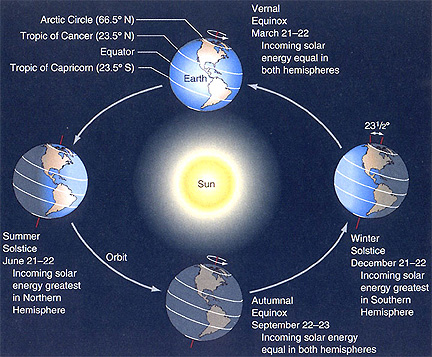
Summer Solstice/ Midsummer is steeped in ancient folklore especially in Northern Europe with the most famous place directly related to it being Stonehenge, where the sun has been worshiped for thousands of years.

The Sun reaches its most Northerly point in the sky at 17:16 UTC momentarily and from that point forward starts to make its way South. This means the days will get shorter and shorter until Winter Solstice in December.

